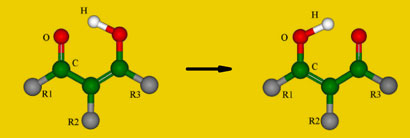A quantum simulation has successfully described the progression of a chemical reaction for the first time. Researchers in China and Singapore used three quantum bits, or qubits, to mimic a laser-driven isomerisation reaction of malonaldehyde molecules.
In classical computing, each additional variable in the calculation of a chemical reaction exponentially increases the computing power needed to complete it. Qubits, can exist in two states simultaneously - superpositions - and this multitasking allows the required computing power to rise much more slowly.

Three quantum bits in diethylfluoromalonate were used to model the isomerisation of malonaldehyde (above)
© Physical Review Letters
|
Unfortunately, quantum bits are difficult to maintain and handle without introducing errors. Franco Nori, leader of the digital materials team at RIKEN in Wako, Japan, says that general purpose quantum computers won't be able to outdo classical computers for another couple of decades. Even so, Ivan Kassal, an expert in quantum simulation of chemistry at the University of Queensland in Australia, believes that quantum simulators, designed to carry out specific calculations, could become useful earlier.
For their proof-of-principle quantum simulator, Jiangfeng Du of the University of Science and Technology in Hefei, China and colleagues used the nuclear spins of three atoms - carbon-13, hydrogen and fluorine-19 - as qubits, which were centrally located in a diethylfluoromalonate molecule. The nuclei were both controlled and observed using nuclear magnetic resonance (NMR) spectroscopy. The NMR magnetic fields were used to manipulate the nuclear spins to create superpositions between their aligned and anti-aligned states.
Then, specially shaped pulse of radiofrequency (RF) electromagnetic radiation were applied using the spectrometer to drop the three qubits in diethylfluoromalonate into their quantum ground state, corresponding to the state malonaldehyde is in prior to the start of laser driven isomerisation. Another 25 shaped pulses manipulated the spins of the nuclei, simulating the energy delivered to the malonaldehyde molecules by the laser.
The RF pulses also served as probes, allowing the researchers to track the evolution of the qubit states. Over 30ms, the qubits mimicked the progression from a majority population of the reactant isomer to a majority of the product isomer. The 24 measurements along the way matched the results of a classical simulation of the reaction, verifying that the quantum simulation was accurate.
Kassal calls the experiment a 'significant advance', and Nori is especially impressed with the robustness of the results: they packed the logic gate operations into the RF control pulses, avoiding the accumulation of errors which poses a major challenge in quantum computing.
Du admits that this method of error control is difficult to scale up to larger systems, as it becomes more difficult to achieve high-fidelity pulses, but he says, 'we can use feedback learning control to overcome it'.
Kate McAlpine
Interesting? Spread the word using the 'tools' menu on the left.




